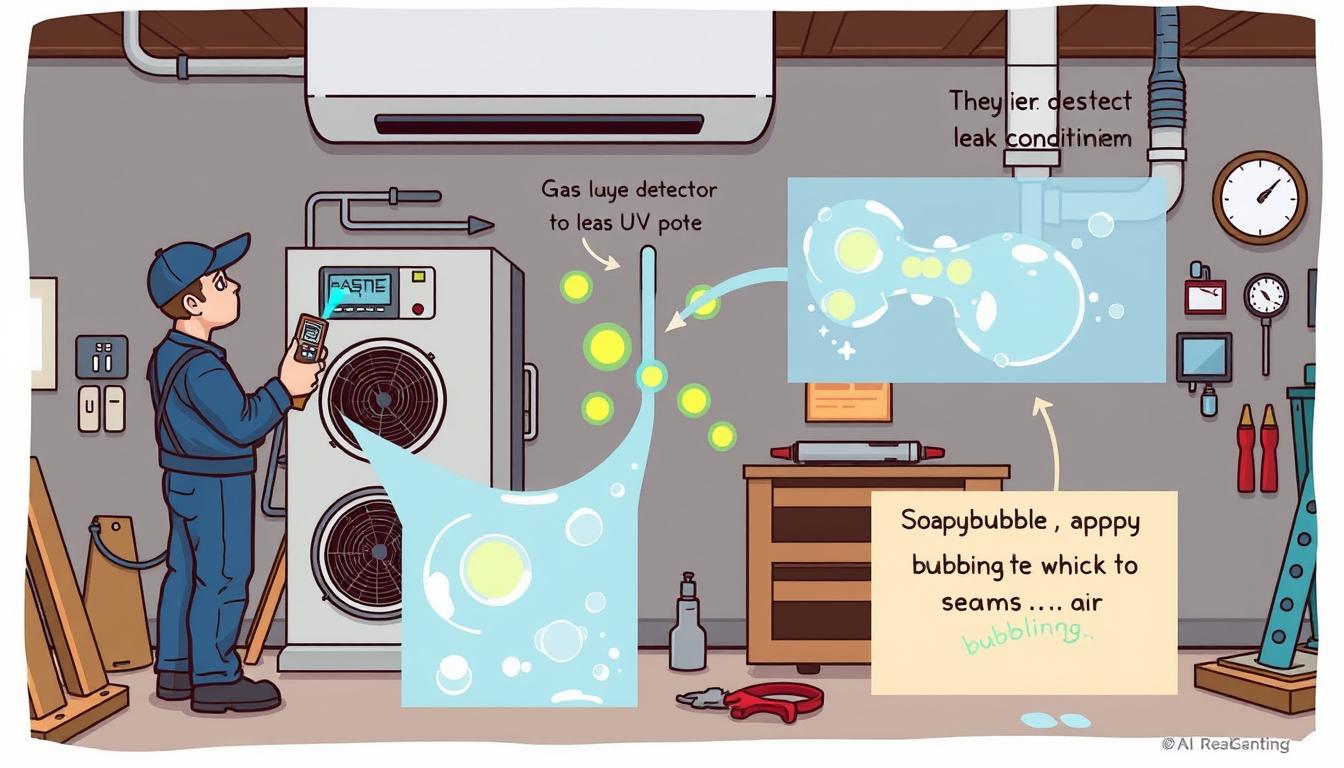There are three main ways to find a leak in your AC system. You can use electronic leak detectors, ultraviolet (UV) dye, or nitrogen pressure testing. Each method helps find and fix refrigerant leaks quickly and effectively.
Key Takeaways
- Electronic leak detectors use advanced sensors to detect the presence of refrigerant outside the AC system.
- Ultraviolet (UV) dye is injected into the system, and a special light is used to identify the exact location of the leak.
- Nitrogen pressure testing involves pumping nitrogen into the system and listening for audible leaks or monitoring pressure changes.
- Each method offers a unique approach to finding leaks, allowing you to address the issue efficiently.
- Choosing the right method depends on the specific circumstances and the severity of the leak.
Introduction: Addressing AC Refrigerant Leaks
Keeping your air conditioning (AC) system running well is key for comfort and saving energy. A common problem is a refrigerant leak. This can cause big issues if not fixed. We’ll talk about why finding and fixing leaks is important, and what happens if you ignore them.
Importance of Detecting and Fixing Refrigerant Leaks
Refrigerants are vital for cooling your home. Refrigerant leaks can hurt your system’s performance and efficiency. This leads to less cooling and higher energy use. It’s crucial to find and fix these leaks to keep your AC system healthy and working right.
Potential Consequences of Ignoring Leaks
Not fixing AC refrigerant leaks can cause big problems. You might not cool your home enough, spend more on energy, or even have frozen coils. These issues can get worse, leading to expensive repairs or even needing a new system. It’s important to regularly check for leaks and fix them quickly to avoid these issues.
We’ll look closer at how to find and fix AC system refrigerant leaks in the next parts. We’ll also talk about why keeping up with AC system maintenance is key to avoiding future problems. By acting early, you can keep your home cool and your energy bills low.
Performing a Visual Inspection
One of the simplest ways to detect a potential refrigerant leak in your air conditioning (AC) system is by conducting a thorough visual inspection. This technique can uncover several tell-tale signs that may indicate an AC refrigerant leak.
Listening for Unusual Sounds
As you inspect your AC unit, be attentive to any unusual sounds, such as hissing or bubbling. These sounds can often point to a leak in the refrigerant lines or other components of the system.
Checking for Signs of Dirt or Oil Accumulation
Another important step in the visual inspection process is to closely examine the AC unit for any signs of dirt or oil buildup around fittings, connections, and other components. This type of residue can be a clear indicator of an AC refrigerant leak.
While a visual inspection is a great starting point, it may not always uncover all potential leak sources. Additional testing methods, such as using soapy water or specialized leak detection tools, may be necessary to fully identify and address any issues within your AC system.
| Potential Signs of an AC Refrigerant Leak | Description |
|---|---|
| Unusual Sounds | Listen for hissing, bubbling, or other unusual noises coming from the AC unit, as these can indicate a refrigerant leak. |
| Dirt and Oil Buildup | Examine the AC system for any signs of dirt, dust, or oil accumulation around fittings, connections, and other components, as this can be a telltale sign of a refrigerant leak. |
| Visible Leaks | Look for any visible liquid or vapor escaping from the AC unit, which could be a clear indication of a refrigerant leak. |
Using Soapy Water
Testing for AC refrigerant leaks can be easy. You can use the soap bubble test, a simple DIY method. It involves making a soapy water solution and spraying it on possible leak spots in your AC system.
If there’s a leak, bubbles will show up in the soapy water. This tells you exactly where the leak is. This AC refrigerant leak test is a handy way to spot problems without needing fancy tools.
How to Perform a Soap Bubble Test
- Mix mild dish soap with water in a spray bottle.
- Look over your AC system, especially at connections and joints.
- Spray the soapy water on the spots you think might leak.
- Watch for bubbles, which mean you have a AC refrigerant leak.
- Mark where the leak is so you can fix it later.
The soap bubble test is a basic, DIY leak detection method. It’s not perfect but it’s a good start for finding AC system problems. It’s also very affordable.
It’s important to fix refrigerant leaks fast. They can make your AC system less efficient and shorter-lived. If you find a leak with the soap bubble test, get a pro to check and fix it.
What three methods can be used to find a leak in the AC system?
There are several ways to find refrigerant leaks in your AC system. The main methods are electronic leak detectors, ultraviolet (UV) dye, and nitrogen pressure testing. Each method has its own benefits and can help find the leak fast and accurately.
Electronic Leak Detectors
Electronic leak detectors are top-notch for finding AC refrigerant leaks. They use advanced sensors to spot refrigerant outside the system. This lets you find the leak’s exact spot. Plus, they can tell different refrigerants apart, making them useful for many AC systems.
Ultraviolet (UV) Dye
Using ultraviolet (UV) dye is another good AC leak detection method. A small amount of dye is added to the refrigerant system. Then, a UV dye leak test shows leaks by glowing under UV light.
Nitrogen Pressure Test
The nitrogen pressure test is a straightforward way to find leaks. The system is filled with nitrogen gas. Then, the technician listens for leaks or checks the pressure gauge for drops.
Using these AC leak detection methods helps find and fix refrigerant leaks fast. This keeps your AC system running well and saves energy.
Professional Leak Detection Methods
As an HVAC technician, finding refrigerant leaks in air conditioning systems is key. Basic methods can help, but professional techniques are more reliable. HVAC techs often use electronic leak detectors and ultraviolet fluorescent dye testing.
Electronic Leak Detectors with Advanced Sensors
Electronic leak detectors with heated diode, corona suppression, or infrared sensors are very precise. They can find even the smallest refrigerant leaks. This lets HVAC techs fix problems quickly and efficiently.
These detectors are crucial for professional AC leak detection.
Ultraviolet Fluorescent Dye Testing
HVAC technician leak detection experts also use ultraviolet (UV) fluorescent dye. They add a bit of dye to the refrigerant. When UV light hits it, leaks glow, showing where they are.
This method is great for finding and fixing leaks fast.
These advanced methods might cost more than DIY options. But, they offer better accuracy and thoroughness. This makes them a good investment for keeping air conditioning systems running well.

Signs of Low Refrigerant Levels
If your AC system isn’t cooling right, it might have low refrigerant levels. Refrigerant is key for your AC’s health. A small leak can greatly affect its performance and efficiency. Here are the signs your AC might be low on refrigerant.
Insufficient Cooling
One clear sign of low refrigerant is if your space isn’t cooling enough. Even when your AC is working hard, it might not cool your home or office as it should. This makes it hard for the AC to cool the air, making your space less comfortable.
Higher Energy Bills
Another sign is a sudden increase in your energy bills. With a refrigerant leak, your AC uses more electricity to try to cool. This can lead to higher monthly bills, which is not only frustrating but also costly.
Frozen Evaporator Coils
A less obvious but serious sign is frozen evaporator coils. Low refrigerant can cause the coils to freeze, reducing cooling power. This can damage your AC’s compressor and other important parts.
If you see any of these low refrigerant signs, get your AC checked by a pro. A refrigerant leak can cause big problems and expensive repairs if ignored. Fixing it quickly will help keep your AC not cooling properly and prevent high AC energy bills.
Safety Considerations
When dealing with AC refrigerant leaks, it’s crucial to exercise caution. Refrigerants can be hazardous if not handled properly, potentially causing health issues with exposure. For this reason, it’s generally recommended to seek the assistance of a qualified HVAC technician when addressing refrigerant leaks.
Handling Refrigerants with Caution
Refrigerants used in air conditioning systems can be toxic and flammable. Improper handling or exposure to these chemicals can lead to various health problems, including respiratory issues, skin irritation, and even frostbite. HVAC technicians are trained to safely handle and contain refrigerant leaks, ensuring the safety of both the homeowner and the technician.
Seeking Professional Assistance
- Attempting DIY refrigerant repairs without the right knowledge and tools can be risky and may even exacerbate the problem.
- Professional AC repair technicians have the necessary equipment, personal protective gear, and expertise to identify, contain, and fix refrigerant leaks safely.
- Trying to handle refrigerant leaks on your own could lead to further damage to your HVAC system or even personal injury.
It’s always best to leave the task of repairing AC refrigerant leaks to qualified HVAC technicians who can ensure the job is done safely and effectively, protecting both you and your home’s cooling system.

Maintaining Your AC System
Keeping your AC system in top shape is key to a cool home. Regular checks and upkeep help catch problems early. This way, you avoid bigger issues later on.
Regular Inspections and Maintenance
Experts say your AC should get checked and serviced yearly, before it gets hot. This helps find and fix problems like refrigerant leaks fast. Regular checks keep your AC running well and saves energy.
Addressing Leaks Promptly
If you find a leak, fix it fast. Ignoring it can make your AC work less well and cost more to run. Quick repairs keep your AC cooling your home all summer.
Regular checks and quick fixes are the secret to a cool home all summer. Don’t skip these steps!
Conclusion
Refrigerant leaks in your air conditioning (AC) system are a common issue that require prompt attention. By understanding the various leak detection methods available, you can take proactive steps to identify and address any issues before they escalate. From visual inspections to advanced electronic and UV dye techniques, there are several effective ways to pinpoint the source of a leak.
For a comprehensive and safe leak detection process, it’s often best to enlist the help of a qualified HVAC professional. They have the expertise and specialized equipment to thoroughly inspect your system and provide reliable solutions. Regular maintenance and prompt leak repair are also crucial for ensuring your AC unit operates efficiently and keeps your home cool all season long.
By staying vigilant and addressing refrigerant leaks in a timely manner, you can extend the lifespan of your AC system, reduce energy costs, and maintain a comfortable indoor environment for your family. Investing in proper leak detection and repair is a small price to pay to keep your cooling system running at its best.





0 Comments